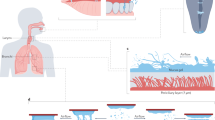Abstract
The natural convection boundary layer surrounding the human body is capable of transporting particles such as dust, skin scales, pollens and spores and provides a link in the chain of airborne infection. Experiments have made in a laminar flow channel and in the flow over a full-sized heated model of the human form to visualise and analyse the trajectories of these particles.
Sommaire
A l'intérieur de la zone de convection naturelle qui entoure le corps de l'homme, s'effectue le transport de particules telles que poussières, écailles de peau, pollens et spores qui constituent un maillon dans la chaîne des infections se transmettant par l'air. On a conduit des expériences dans un écoulement laminaire ainsi que dans l'écoulement se produisant autour d'un mannequin chauffé en grandeur nature d'un corps humain afin de visualiser et d'analyser les trajectoires de ces particules.
Zusammenfassung
Die natürliche Konvektionsgrenzchicht, die den menschlichen Körper umgibt, kann Partikel wie Staub, Hautschuppen, Pollen und Sporen transportieren und bildet damit ein Glied in der Kette durch die Luft übertragener Infektion. Versuche wurden angestellt in einem Laminarströmungskanal bzw. im Strömungsbild eines lebensgroßen erwärmten Modells der menschlichen Form, um die Flugbahnen dieser Partikel sichtbar zu machen und zu analysieren.
Similar content being viewed by others
Abbreviations
- μm:
-
micrometre
- u t :
-
particle terminal fall velocity
- Re :
-
particle Reynolds numberU t d/v=inertia forces/viscous forces
- v :
-
kinematic viscosity of air
- U :
-
air velocity
- d :
-
particle diameter
- C t :
-
particle lift coefficient-L/1/2ρu 2 S
- L :
-
lift force on particle
- S :
-
particle projected area
- C d :
-
particle drag coefficient=D/1/2ρU 2 S
- D :
-
drag force on particle
- ρ:
-
air density
References
Marples, M. J. (1969) Life on the human skin.Scient. Am.220, 108.
Goldsmith, H. L. andMason, S. G. (1962) The flow of suspensions through tubes. 1—Single spheres, rods and discs.J. Colloid Sci.17, 448–476.
Segré, G. andSilberberg, J. (1962) Behaviour of macroscopic rigid spheres in Poiseuille flow. Pt. 1.J. Fluid. Mech.14, 115–136.
Imai, I. (1954). A new method for solving Oseen's equation and its application to the flow past an inclined elliptic cylinder.Proc. Roy. Soc.224a, 7.
Author information
Authors and Affiliations
Rights and permissions
About this article
Cite this article
Clark, R.P., Cox, R.N. An application of aeronautical techniques to physiology 2. Particle transport within the human microenvironment. Med. & biol. Engng. 12, 275–279 (1974). https://doi.org/10.1007/BF02477791
Received:
Accepted:
Issue Date:
DOI: https://doi.org/10.1007/BF02477791




